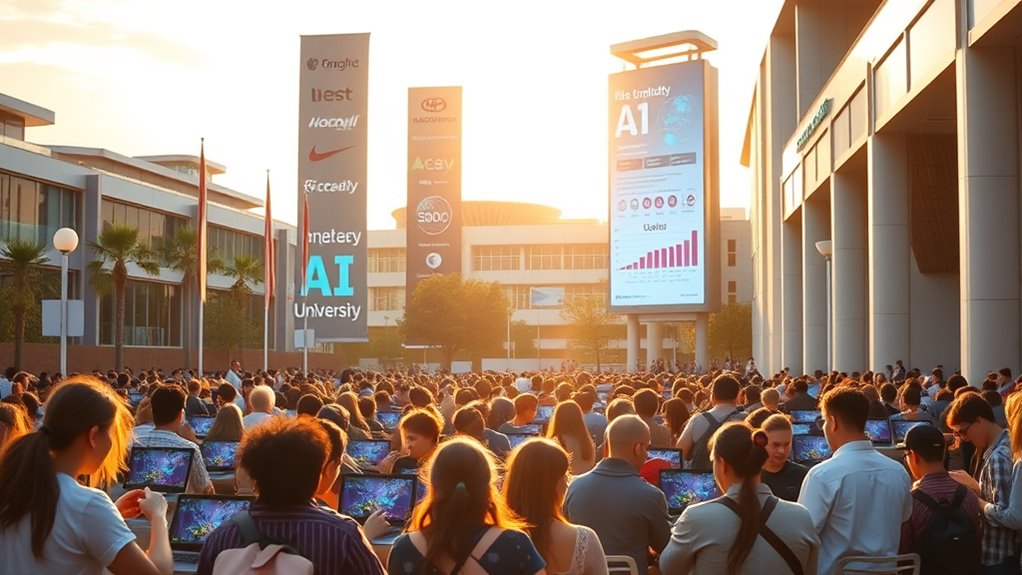The AI education race is heating up as big tech giants like Google, Microsoft, and Apple invest billions into developing personalized, adaptive learning tools. The market is expected to grow from nearly $4 billion in 2023 to over $112 billion in the early 2030s, fueled by demand for innovative digital solutions. If you want to understand how these investments are shaping the future of learning and the competitive landscape, keep going.
Key Takeaways
- Major tech giants like Google, Microsoft, Apple, and IBM are investing billions in AI education tools and platforms.
- These companies fund research, develop personalized learning solutions, and integrate AI into classrooms worldwide.
- Public-private partnerships and startup collaborations accelerate innovation and adoption of AI in education.
- Significant investments from big tech are driving rapid market growth, expected to reach over $112 billion by the early 2030s.
- The race to dominate AI-driven education is intensifying, with big tech firms leading the strategic and financial push.

As AI technology rapidly transforms the education landscape, countries and companies are racing to capitalize on its potential. The market for AI in education is booming, valued at around $3.99 billion in 2023 and expected to surge to as much as $7.77 billion by 2025. Looking ahead, projections suggest it could reach between $17 billion and over $112 billion by the early 2030s. This rapid growth, with compound annual rates between 31% and 43%, is driven by the push for personalized learning, adaptive platforms, administrative automation, and the expansion of digital infrastructure. North America currently dominates the market, thanks to significant investments from major tech firms and government spending, while the Asia-Pacific region is the fastest-growing area, fueled by policies promoting AI literacy and digital education. The global AI in education market is projected to grow at a CAGR of 42.83% through 2030, reflecting its rapid expansion and significance. Leading technologies like machine learning and cloud-based platforms are shaping this shift. Over 70% of the revenue comes from software solutions, with cloud deployment accounting for more than 60%, reflecting the move toward scalable, online systems. Machine learning holds around 65% of the AI market share in education, powering adaptive assessment and grading systems that are growing at nearly 45% annually. Virtual learning environments and intelligent tutoring systems are among the most lucrative applications, transforming how students learn and how educators teach. Big tech companies such as Google, Microsoft, Apple, IBM, and Pearson are pouring billions into AI educational tools. These giants fund research, develop innovative platforms, and integrate AI to offer more personalized instruction. Meanwhile, startups focusing on tutoring and content delivery are gaining ground, supported by public-private partnerships and government initiatives. Today, about 60% of educators in the U.S. have integrated some form of AI into their classrooms, using tools like educational games, adaptive learning platforms, and intelligent tutoring systems. AI helps teachers customize lessons, automate grading, and give personalized feedback, while students use AI for homework help and concept clarification—especially since generative AI tools like ChatGPT became widely accessible after 2022. Regionally, North America leads with roughly 38% of the market, driven by strong infrastructure and supportive policies. Asia-Pacific’s aggressive AI education policies boost adoption, with governments mandating AI literacy and digital skills in schools. Although Europe lags behind, increased investments and policy shifts could close the gap. The adoption of AI literacy programs is crucial for future readiness, and efforts are underway globally to address this need. Still, challenges like data privacy regulations and educator skill gaps remain barriers, but the overall momentum indicates a fierce race to dominate the future of AI-driven education.
Frequently Asked Questions
How Will AI Education Impact Student Privacy Rights?
AI education will greatly impact your student privacy rights by increasing data collection and monitoring. You might find your personal information, behaviors, and even location tracked more than ever before. While some measures aim to protect you, gaps in laws and transparency mean your privacy could be at risk. You should stay informed and advocate for clear policies, ensuring your rights are prioritized as AI tools become more integrated into learning environments.
What Measures Ensure Equal Access to AI Learning Tools?
You can guarantee equal access to AI learning tools by promoting inclusive policies that address disparities in technology infrastructure, especially in underserved schools. Support initiatives that provide affordable, culturally responsive AI resources and assistive technologies for diverse learners. Advocate for community programs and educator training to boost understanding and acceptance. Additionally, prioritize transparency, privacy, and non-discrimination in AI systems to make sure all students benefit equally from this evolving educational technology.
Are There Risks of Bias in Ai-Driven Educational Content?
Yes, there are risks of bias in AI-driven educational content. You might encounter stereotypes, misinformation, or unfair treatment of marginalized student groups due to biased training data. These biases can perpetuate inequalities and negatively impact learning experiences. To address this, you should advocate for transparent, inclusive AI development, monitor outputs carefully, and support policies that promote fairness and diversity in AI educational tools.
How Do Proprietary AI Tools Influence Curriculum Neutrality?
Proprietary AI tools can tilt the scales, making curriculum less neutral. You might find that these tools embed their developers’ biases, shaping content to serve commercial interests or cultural views. As a result, your curriculum risks being skewed, favoring certain perspectives over others. This can limit your ability to provide balanced education, as proprietary algorithms often restrict transparency, making it harder to guarantee fairness and maintain diverse, unbiased learning experiences.
What Role Do Governments Play in Regulating AI in Education?
Governments regulate AI in education mainly through existing laws like FERPA, Title IX, and Title VI, which protect student data privacy and prevent discrimination. They provide guidance, funding, and initiatives to promote responsible AI use, while also encouraging innovation through deregulation efforts. Your role involves staying informed about federal and state policies, ensuring compliance, and advocating for ethical, transparent AI integration that benefits students and educators alike.
Conclusion
As you step into this rapidly evolving landscape, imagine the horizon shimmering with endless possibilities, each innovation fueling your curiosity. Big tech’s investments act as guiding stars, illuminating a path toward a future where AI education becomes more accessible and transformative. Feel the pulse of progress beneath your fingertips, igniting a passion to learn and adapt. The race is on, and with every stride, you’re shaping a world where knowledge and technology intertwine seamlessly, forging new frontiers for everyone.










